Fall River's Bioreserve is ideal for winter hiking. Here's how to start and where to go
FALL RIVER — The temperature has fallen to freezing or below, the frost-hardened ground is often covered in snow and ice — and believe it or not, this can be an ideal time to enjoy yourself outside.
The Southeastern Massachusetts Bioreserve, in Fall River’s vast eastern woodland half, has 50 miles of beautiful nature trails open for all kinds of outdoors fun — and when the trees and terrain are blanketed in snow, it’s still a perfect place for everything from taking a walk, mountain biking, cross-country skiing, snowshoeing and more. People have even been known to hitch up dog-sleds on the trails.
“If we get snow, it is a great place to go cross-country skiing or snowshoeing," says Paul Audet, an avid outdoors enthusiast. He grew up in Fall River, enjoying the Bioreserve as a hunting ground, and now lives a stone’s throw from it in Westport.
The Bioreserve’s 16,000 acres are relatively flat, and during snowy weather he’s seen cross-country skiiers head north up Blossom Road to enjoy fresh powder. “They'll park at the gate, and they'll just ski that nice fire road," he says. “You can go in the winter time and you'll see tracks.”
Beyond the 'Satanic Panic': Fall River Bioreserve's true story is full of history and beauty
Why go hiking in the winter?
Winter in Fall River's Bioreserve can be a good training ground for people new to hiking to get used to the sport without some of the downsides. The Bioreserve is right in the city’s backyard, and the trails aren’t too far from civilization, so there’s no major time commitment. The flatness is perfect for people who want to soak in a gorgeous natural landscape but aren't ready to climb mountains. Some people new to hiking get frustrated by tripping over roots and rocks — that's less of a problem when there’s snow cover.
Plus, you save money on insect repellent.
“There’s no bugs in the winter time,” says Barry Young, a winter hike leader and past chapter chair of the Appalachian Mountain Club, Southeastern Massachusetts chapter. “There’s no mosquitoes and horse flies — you're not swatting your face.”
They’re not the only bug winter hikers avoid — there's less risk of seeing ticks if the temperature is under 40 degrees.
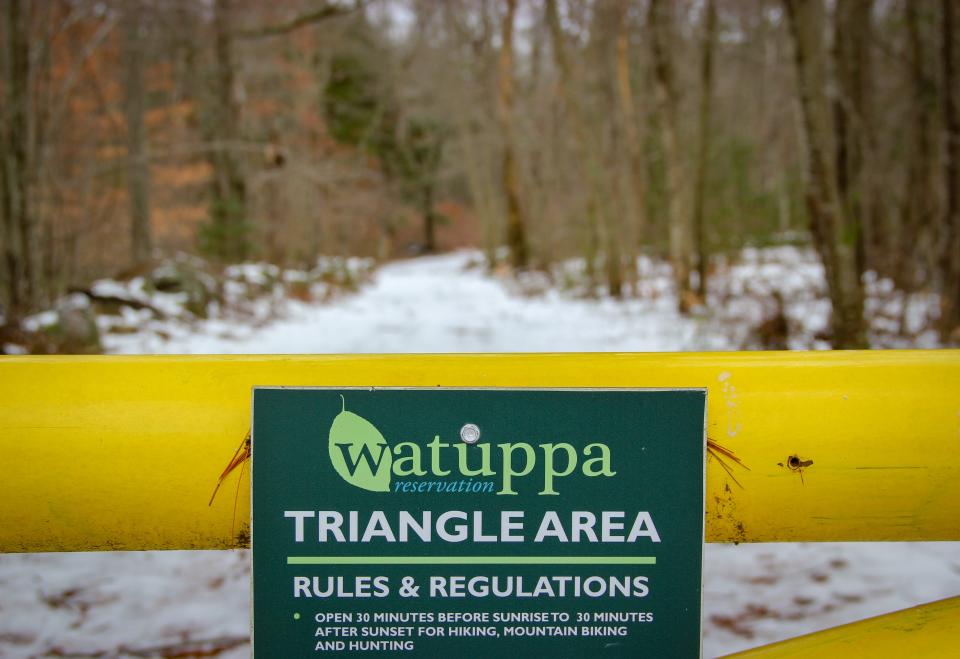
Blazing new trails: Fall River's Bioreserve to expand hiking paths, and add access for wheelchairs and kids
Winter hiking offers other pleasures not seen during the other three seasons, like being better able to spot animal tracks in the snow, and having less risk of overheating.
“If you’re cold, you can layer up, put on an extra piece of clothing that you have in a backpack,” Audet says. “In the summertime, if you’re too hot, there’s only so much you can take off.”
But those with experience seem to relish one aspect of winter hiking above all: the silence.
“If you go to the Bioreserve in the wintertime, it is so quiet,” Audet said. "It’s beautiful.”
A blanket of snow not only adds beauty to the vistas you can see in the Bioreserve, but dampens sound, making the forest in winter a peaceful place to think, recharge mental batteries, be close to nature.
“It’s just a different experience,” Audet says. "People are losing it now. … You just gotta go out, find a peaceful place, and get out there."
That said, winter hiking also poses unique challenges compared to three-season hiking, especially for those who are new to it or underestimate how powerful nature can be. Here are some do’s and don’ts when it comes to winter hiking, including tips on how to get started, and a few local hikes in Fall River to tag along with people who have experience.
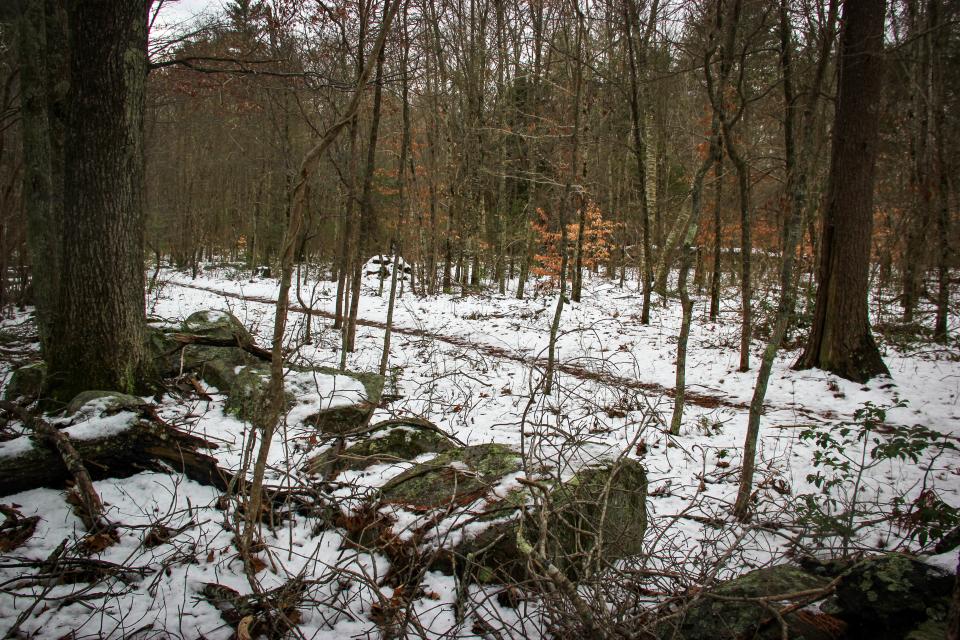
'Great natural treasure': Hiking club is leading free tours of Fall River's Bioreserve — here's how to join
Do: Check the weather
Before you do anything, check the weather forecast for where and when you’re going to note the sky conditions, the temperature, the wind, and any rain or snow that might fall. These factors can affect how you’ll have to dress and what you’ll need to bring with you.
It’s also a good idea to help plan your day. “This time of the year,” Audet says, “it gets darker, faster. If you're not familiar with the Bioreserve, it's easy to be walking and miss a turn. So now even if you know where you are, you might have just added an extra hour of walking time.”
Do: Wear layers and stay dry
Obviously if you’re planning to spend a couple of hours walking through snow in cold weather, you’ll have to bundle up. But there's a right way to do it and a wrong way.
The right way is to use the WISE system: wear a wicking layer, at least one insulating layer, a shell layer, and a layer for your extremities. Young says hikers can start off feeling cold, but then quickly warm up as they get moving, and it’s important to add or remove layers to keep their body temperature regulated.
“The one thing you don't want to do is start to get too warm so that you start to sweat and get moisture building up on your body,” Young says.
If your body and clothes get wet from sweat, they won’t dry out — you'll just stay cold and wet, which can cause your body temperature to drop quickly.
"You can get into a situation where you might get into hypothermia or something like that — rare, but it can happen,” Young says.
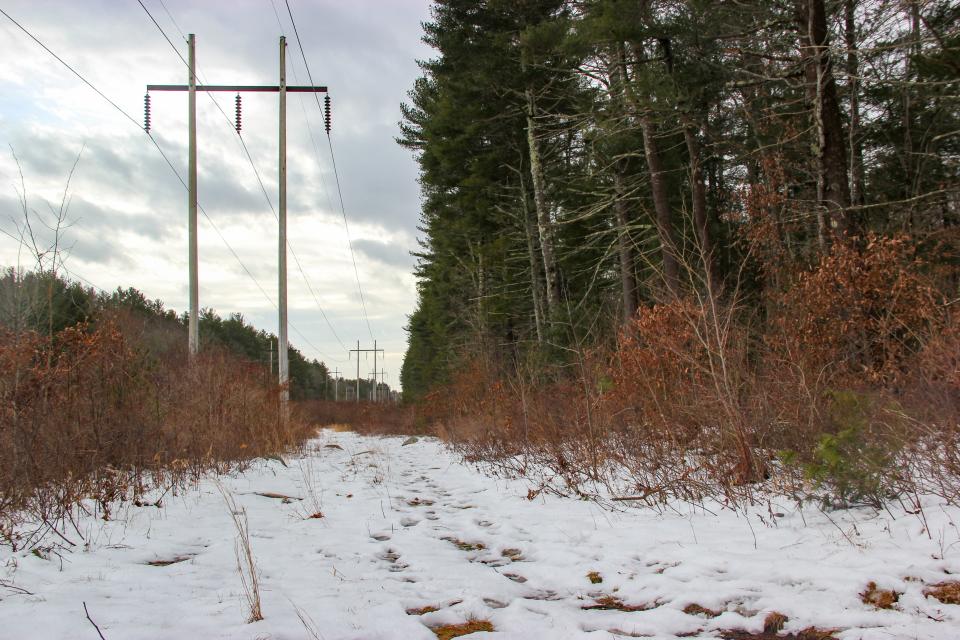
Leading the way: Fall River Eagle Scout candidate builds info kiosk at Bioreserve nature trail
Don’t: Wear cotton
The layer closest to your skin should never be cotton. A cotton shirt will soak up moisture and retain it, keeping you cold. Instead, wear a shirt that’s moisture-wicking made with polyester, nylon, or merino wool. It should be long-sleeved, and be snug and comfortable.
For your lower half, get some moisture-wicking thermal tights. “Depending on how windy or cold it is, I start with an Under Armour type of legging pants," Audet says.
No cotton means no jeans, either. If jeans get wet, they’ll stay wet and leave you freezing cold. Pick up a pair of hiking pants.
Do: Keep yourself insulated
Above your base wicking layer, your insulating layer should be looser-fitting. Young recommends wearing fleece, and the AMC suggests further options like wool, down, and other synthetics. Over that, wear a shell layer that can keep out the wind and won’t soak up moisture. You might want to bring a few extra layers in a backpack, just in case — that way if anything gets damp, you have backups.
“If you feel you're getting too warm, you start taking layers off, and put them in your little daypack,” Young says.
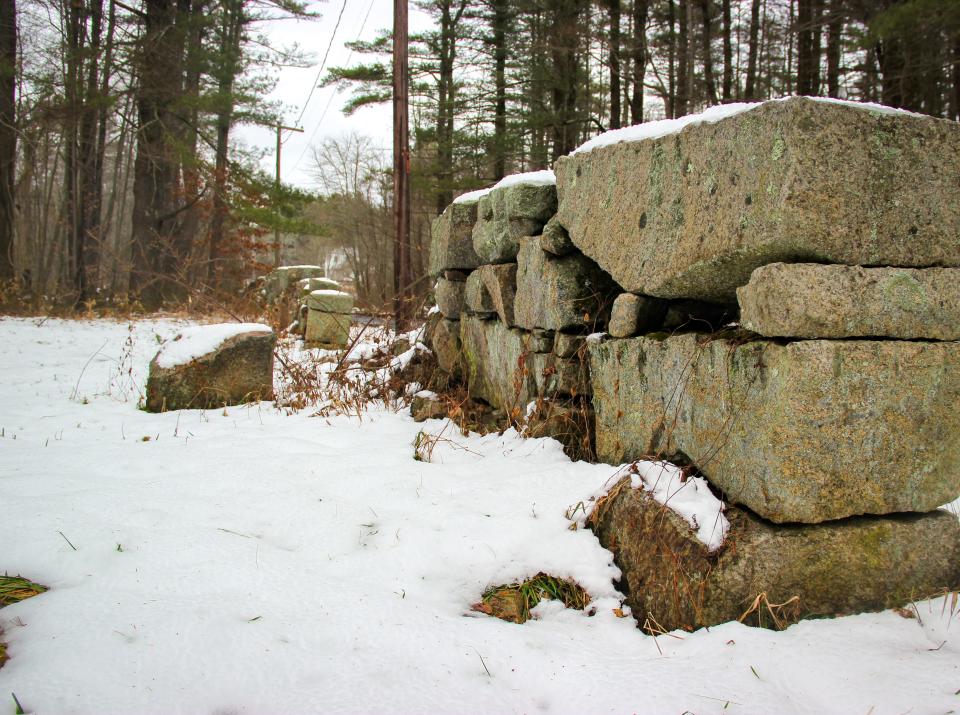
Do: Protect your extremities
When it comes to your hands, you’ll want to wear gloves that will stay dry and keep out the elements. “Some people recommend mittens because your fingers are together and they stay warmer that way,” Audet says.
AMC recommends wearing merino wool socks made for winter, since they're thicker than summer socks and will wick away moisture, keeping your feet dry. “You don't have to pay a lot for the socks," Audet says. “I can get wool socks at Job Lot for three bucks a pair and they're great.”
And don't wear sneakers — if you’re walking in snow, sneakers won’t be insulated enough to protect your feet from the cold for very long.
"You would want some waterproof hiking boots,” Young says. "The ones I have are actually Gore-Tex. So they breathe in one way, but they don't let water in the other way. You don't want moisture building up on your feet.”
Don't: Get lost
The Bioreserve has miles of trails, but they're not all perfectly marked. You'll want to bring a map with you — you can find a paper copy at the Freetown-Fall River State Forest headquarters, or download a map to your phone here. Audet suggests also throwing a whistle in your backpack. You may never use it, but take it in case of emergency. "That's good on any hike," he says. "But for winter hikes, don't bring a metal one."
Do: Consider traction devices
Depending on how snowy and icy conditions are on the Bioreserve trails, your boots might need some extra grip. Microspikes or nanospikes are metal devices connected by chains that you strap to the soles of your boots, biting into the ice. They’re available at sporting goods stores, though AMC Chair Diane Simms says she once found a cheaper, perfectly serviceable pair at Job Lot.
“The one thing to avoid is the kind that they sell like if you want to shovel your driveway,” Audet says. “They look like they have springs under them. Those slip — those are like ice skates.”
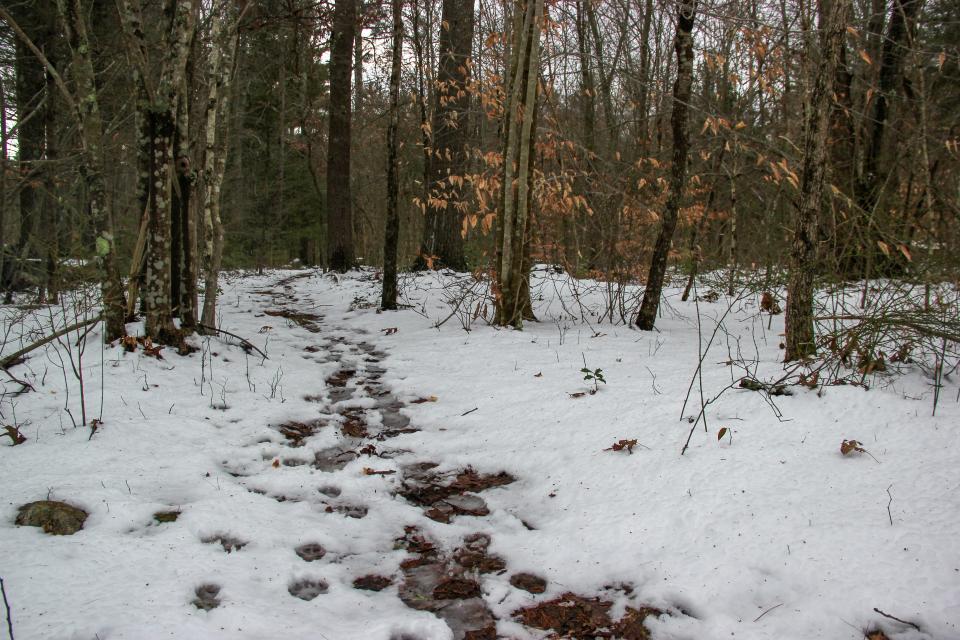
Don’t: Forget to eat and drink
It’s cold and you’re not sweating like you would in summer, but you still need to drink. “You are losing moisture when you breathe,” Young says. “It's cold, so now you can actually see your breath, right? So you're losing water. You want to make sure that you continue to hydrate.”
The AMC recommends bringing a wide-mouthed bottle of hot water, so it doesn’t freeze — and Audet suggests keeping it in an insulator, or even a sock. And no hydration backpacks, since the mouthpiece can freeze.
Snacks are a must if you’re planning on spending a couple of hours on a trail, too. The energy will keep you going, and help your body regulate its temperature.
Do: Protect your phone from the cold
If you’re going to bring a phone (and you should, for emergencies), remember that cold temperatures can kill a smartphone battery within minutes. Audet suggests keeping your phone on airplane mode if you know you’ll be out of cell and wifi range for a while, and you should carry it close to your body so it’ll stay warm — or if it gets too cold, bring along a chemical heat-pack and keep your phone near it (but not directly on it).
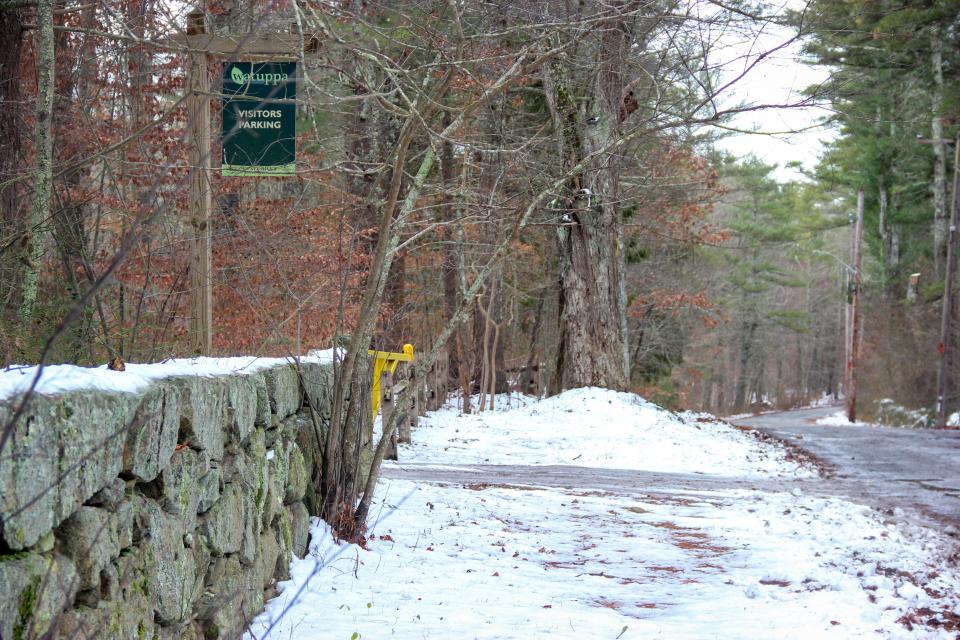
Don't: Spend a lot of money at first
A glance at all the gear might make it seem like you need to shell out a ton of dough just to go walking in the woods, but you don't — start by checking places like Ocean State Job Lot, Savers, Goodwill, and thrift stores. Stores like REI, Eastern Mountain Sports, L.L. Bean and other shops have higher-end gear for enthusiasts, but cheap stuff can be fine if you're starting out, as long as it works.

Do: Learn from people with experience
If you’re new to hiking, you should know your limits and make sure you don’t take on more than you can handle, especially when the weather is extreme.
Group hikes are the best way to experience the Bioreserve while learning good practices from others.
"The best advice I could give somebody is, if you go on a hike or winter hike, see how everybody else dresses," Audet says. "Ask ahead."
Young has been a winter hike leader for AMC for eight years, which requires extensive training courses and wilderness first aid. He leads hikes for AMC through Fall River and the southeastern part of the state, and his group stresses safety.
“We have a philosophy, no hiker left behind," Young says. “Somebody gets hurt, or is struggling, we have a leader walk them out who stays with them. … And a lot of people like that, because they know they're safe. You know that there's somebody who's going to help them and they're not going to fail.”
Dan Medeiros can be reached at dmedeiros@heraldnews.com. Support local journalism by purchasing a digital or print subscription to The Herald News today.
This article originally appeared on The Herald News: Winter hiking in Fall River Bioreserve: Dos and don'ts of outdoors

